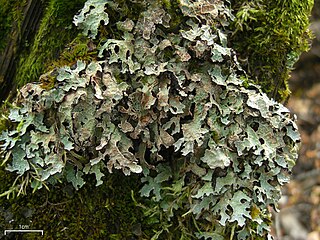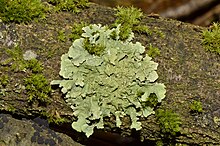
A lichen is a composite organism that arises from algae or cyanobacteria living among filaments of multiple fungi species in a mutualistic relationship. Lichens are important actors in nutrient cycling and act as producers which many higher trophic feeders feed on, such as reindeer, gastropods, nematodes, mites, and springtails. Lichens have properties different from those of their component organisms. They come in many colors, sizes, and forms and are sometimes plant-like, but are not plants. They may have tiny, leafless branches (fruticose); flat leaf-like structures (foliose); grow crust-like, adhering tightly to a surface (substrate) like a thick coat of paint (crustose); have a powder-like appearance (leprose); or other growth forms.

The Collemataceae are a lichenized family of fungi in the order Peltigerales. The family contains ten genera and about 325 species. The family has a widespread distribution.

Cryptothecia rubrocincta is a species of lichen in the fungal family Arthoniaceae. The species is distributed in subtropical and tropical locations throughout the southeastern United States, as well as Central and South America, and has been collected infrequently in a few locales in Africa. The body of the lichen forms continuous, circular crust-like patches on dead wood, readily recognizable by the prominent red pigment. The older, central region is covered with red, spherical to cylindrical granules. Moving outwards from the center, zones of color may be distinguished, the first gray-green, the second white, and finally a bright red cottony rim. The red and green colors of this unmistakable woodland lichen give the appearance of a Christmas wreath, suggestive of its common North American name, the Christmas (wreath) lichen. The red pigment, called chiodectonic acid, is one of several chemicals the lichen produces to help tolerate inhospitable growing conditions.

Pilophorus acicularis, commonly known as the nail lichen or the devil's matchstick lichen, is a species of matchstick lichen in the family Cladoniaceae.

A fruticose lichen is a form of lichen fungi that is characterized by a coral-like shrubby or bushy growth structure. It is formed from a symbiotic relationship of a photobiont such as green algae or less commonly cyanobacteria and one, two or more mycobionts. Fruticose lichens are not a monophyletic and holophyletic lineage, but is a form encountered in many classes. Fruticose lichens have a complex vegetation structure, and are characterized by an ascending, bushy or pendulous appearance. As with other lichens, many fruticose lichens can endure high degrees of desiccation. They grow slowly and often occur in habitats such as on tree barks, on rock surfaces and on soils in the Arctic and mountain regions.

Crustose lichens are lichens that form a crust which strongly adheres to the substrate, making separation from the substrate impossible without destruction. The basic structure of crustose lichens consists of a cortex layer, an algal layer, and a medulla. The upper cortex layer is differentiated and is usually pigmented. The algal layer lies beneath the cortex. The medulla fastens the lichen to the substrate and is made up of fungal hyphae. The surface of crustose lichens is characterized by branching cracks that periodically close in response to climatic variations such as alternate wetting and drying regimes.

Foliose lichen is one of the morphological classes of lichens, which are complex organisms that arise from the symbiotic relationship between fungi and a photosynthetic partner, typically algae. This partnership allows lichen to live in diverse climates that can range from cold, dry mountains to wet, warm valleys. Lichens develop quite slowly with recorded growth rates of 0.01–27mm/year depending on the species. Their lifespan averages between 30 and 60 years.

Lichens are symbiotic organisms made up of multiple species: a fungus, one or more photobionts and sometimes a yeast. They are regularly grouped by their external appearance – a characteristic known as their growth form. This form, which is based on the appearance of vegetative part of the lichen, varies depending on the species and the environmental conditions it faces. Those who study lichens (lichenologists) have described a dozen of these forms: areolate, byssoid, calicioid, cladoniform, crustose, filamentous, foliose, fruticose, gelatinous, leprose, placoidioid and squamulose. Traditionally, crustose (flat), foliose (leafy) and fruticose (shrubby) are considered to be the three main forms. In addition to these more formalised, traditional growth types, there are a handful of informal types named for their resemblance to the lichens of specific genera. These include alectorioid, catapyrenioid, cetrarioid, hypogymnioid, parmelioid and usneoid.
Lichen anatomy and physiology is very different from the anatomy and physiology of the fungus and/or algae and/or cyanobacteria that make up the lichen when growing apart from the lichen, either naturally, or in culture. The fungal partner is called the mycobiont. The photosynthetic partner, algae or cyanobacteria, is called the photobiont. The body of a lichens that does not contain reproductive parts of the fungus is called the thallus. The thallus is different from those of either the fungus or alga growing separately. The fungus surrounds the algal cells, often enclosing them within complex fungal tissues unique to lichen associations. In many species the fungus penetrates the algal cell wall, forming penetration pegs or haustoria similar to those produced by pathogenic fungi. Lichens are capable of surviving extremely low levels of water content (poikilohydric). However, the re-configuration of membranes following a period of dehydration requires several minutes at least.

Symbiosis in lichens is the mutually beneficial symbiotic relationship of green algae and/or blue-green algae (cyanobacteria) living among filaments of a fungus, forming lichen.

Lecanora muralis(Protoparmeliopsis muralis) is a waxy looking, pale yellowish green crustose lichen that usually grows in rosettes radiating from a center (placodioid) filled with disc-like yellowish-tan fruiting bodies (apothecia). It grows all over the world. It is extremely variable in its characteristics as a single taxon, and may represent a complex of species. The fruiting body parts have rims of tissue similar to that of the main nonfruiting body (thallus), which is called being lecanorine. It is paler and greener than L. mellea, and more yellow than L. sierrae. In California, it may be the most common member of the Lecanora genus found growing on rocks (saxicolous).

Parmelia barrenoae is a species of foliose lichen in the large family Parmeliaceae. It was formally described as a new species in 2005. Before this, it was lumped together as one of several lichens in the Parmelia sulcata group—a species complex of genetically distinct lookalikes. Parmelia barrenoae is widely distributed, occurring in Europe, western North America, Africa, and Asia.
Acarospora pseudofuscata is a species of saxicolous (rock-dwelling) crustose lichen in the family Acarosporaceae. It occurs on a few islands in the Aegean Sea and in Turkey.

Solorina crocea, commonly known as the orange chocolate chip lichen, is a species of terricolous (ground-dwelling) and foliose (leafy) lichen in the family Peltigeraceae. The lichen, which was first formally described by Carl Linnaeus in 1753, has an arctic–alpine and circumpolar distribution and occurs in Asia, Europe, North America, and New Zealand. It generally grows on the bare ground in sandy soils, often in moist soil near snow patches or seepage areas. Although several forms and varieties of the lichen have been proposed in its history, these are not considered to have any independent taxonomic significance.
Leptogium compactum is a species of corticolous (bark-dwelling), foliose lichen in the family Collemataceae. Found in northwestern North America, it was formally described as a new species in 2016 by Daphne Stone, Frances Anderson, and James Hinds. It is distinguished from related Leptogium species by the tightly packed hyphae in the medulla; this characteristic internal anatomy is alluded to in the species epithet compactum.
Dictyonema album is a species of basidiolichen in the family Hygrophoraceae. It is found in Mauritius, where it grows as an epiphyte on shrubs.
Dictyonema krogiae is a species of basidiolichen in the family Hygrophoraceae. It is found in Kenya, where it grows as an epiphyte on trees. It is often found in association with other lichens, such as Parmotrema, and bryophytes, such as Frullania. A main characteristic that distinguishes it from other closely related species is its clearly defined internal layers, including its contrasting dense photobiont layer and a loose lower cortex.
Nyungwea pycnidiata is a rare species of lichen in the family Opegraphaceae. Found in the North Region of Brazil, it was described as a new species in 2017. It is unique for its adaptation to living on termite nests.
Opegrapha ramisorediata is a rare species of corticolous (bark-dwelling), crustose lichen in the family Opegraphaceae. Known to occur only in northeastern Brazil, it was described as a new species in 2017. It is characterised by a thin, pale greenish-mauve thallus.














